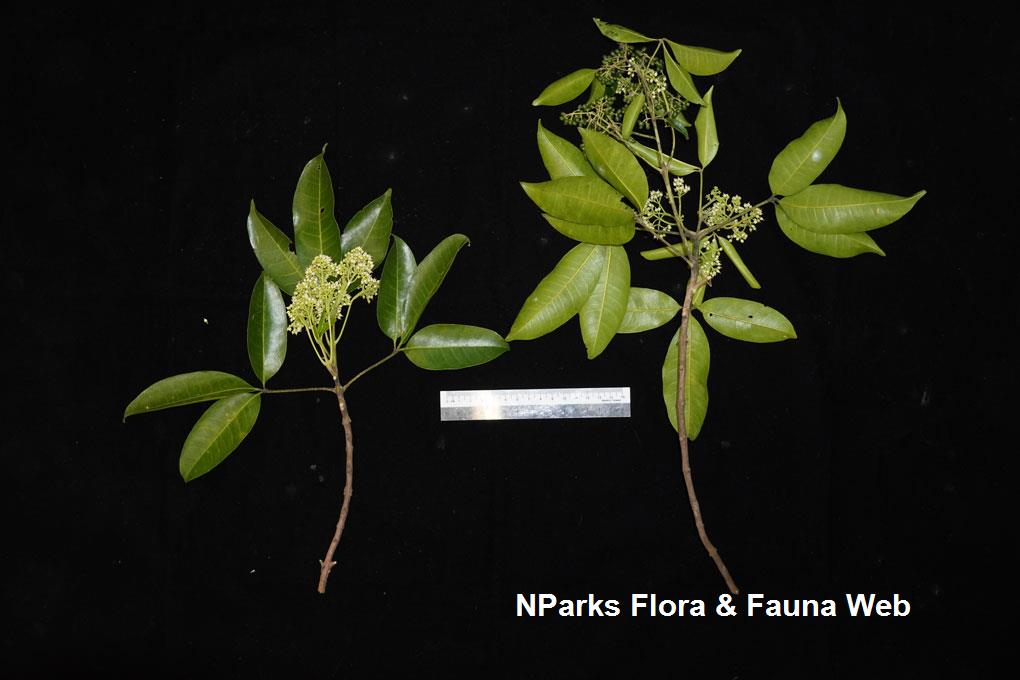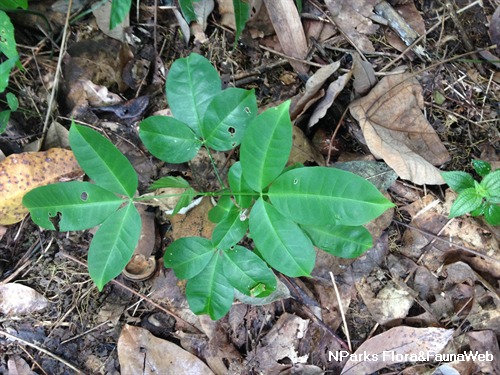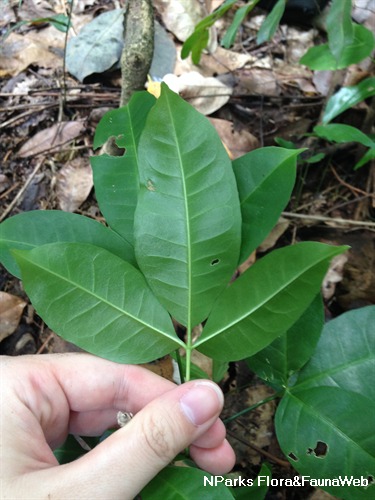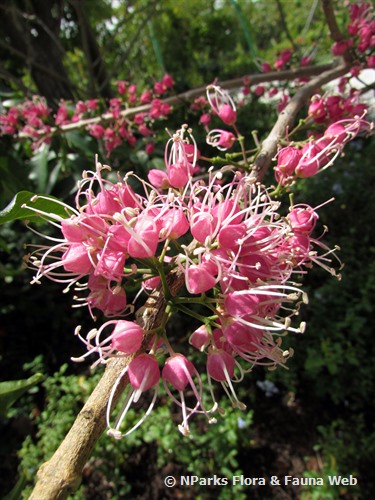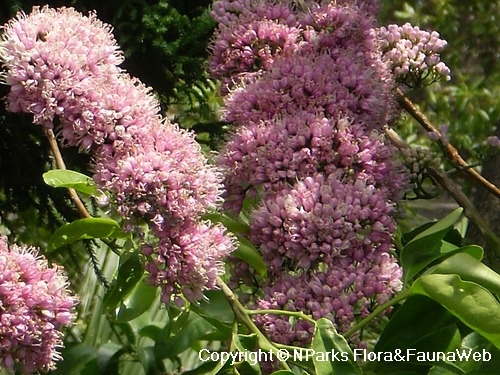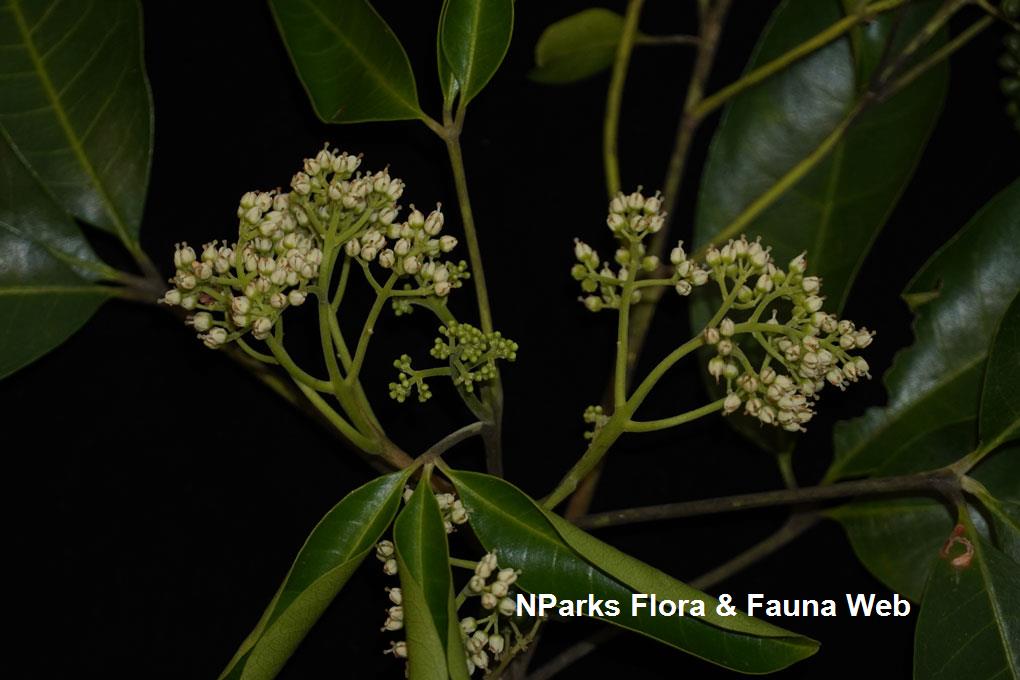
Back
Melicope lunu-ankenda (Gaertn.) T.G.Hartley
| Family Name: | Rutaceae |
| Common Name: | Chabang Tiga, Pepauh, Tenggek Burung, 三刈叶蜜茱萸 |
Melicope lunu-ankenda or Chabang Tiga is a tree native to Singapore. Growing to a height of 30 m tall, it produces trifoliate foliage where each leaflet is elliptic to spoon-shaped. Flowers are dioecious, small, white, 4-petalled, found along the axils. The fruit is a dry, elliptic to egg-shaped follicle that splits to reveal 1 -2 seeds in each cavity (locule).
Name
Classifications and Characteristics
| Plant Division | Angiosperms (Flowering Seed Plants) (Dicotyledon) |
|---|---|
| Plant Growth Form | Tree (Big (>30m)) |
| Lifespan (in Singapore) | Perennial |
| Maximum Height | 30 m |
Biogeography
| Native Distribution | Himalayas, Sri Lanka, Java, Borneo, Philippines, Celebes, Sabah, Sarawak, Brunei, Kalimantan, Singapore |
|---|---|
| Native Habitat | Terrestrial (Primary Rainforest, Secondary Rainforest) |
| Preferred Climate Zone | Tropical |
| Local Conservation Status | Native to Singapore (Endangered (EN)) |
Description and Ethnobotany
| Growth Form | It is a shrub or tall tree that can grow to 30 m tall. |
|---|---|
| Foliage | The leaves are trifoliate, leathery, held on a petiole 1.5 - 15 cm long. Each leaflet is elliptic to spoon-shaped, asymmetrical, measuring 3.5 - 23 cm long by 2.5 - 7 cm wide. The terminal buds are sparsely hairy to velvety. |
| Flowers | Flowers are dioecious where the female and male flowers are found on the same individual. They are small, white and 4-petalled, held on an 2 - 32 cm long inflorescence found along the axils or below the leaves. |
| Fruit | The fruit is a dry, elliptic to egg-shaped follicle measuring 6 - 10 mm long. Each locule contains 1 - 2 round, oval to elliptic seeds measuring 3 - 6 mm long. |
| Habitat | Occurs in primary, secondary, well-drained or swampy forest and montane shrubbery. From near sea-level to 2200m in altitude. <1> |
| Cultivation | It can be propagated by seed. |
Landscaping Features
| Landscaping | Melicope lunu-ankenda is a fast growing species and suitable to reforest various less ideal site conditions. It flowers and fruit easily at 2- 3 m height. |
|---|---|
| Landscape Uses | Reforestation |
Fauna, Pollination and Dispersal
| Fauna Pollination Dispersal Associated Fauna | Butterfly Host Plant (Leaves), Bird-Attracting (Flowers) |
|---|
Plant Care and Propagation
| Light Preference | Full Sun, Semi-Shade |
|---|---|
| Water Preference | Moderate Water |
| Plant Growth Rate | Fast to Moderate |
| Rootzone Tolerance | Fertile Loamy Soils, Well-Drained Soils |
| Propagation Method | Seed |
Foliar
| Foliage Retention | Evergreen |
|---|---|
| Mature Foliage Texture(s) | Leathery |
| Foliar Type | Compound (Trifoliate) |
| Foliar Arrangement Along Stem | Opposite |
| Foliar Attachment to Stem | Petiolate |
| Foliar Shape(s) | |
| Foliar Venation | Pinnate / Net |
| Foliar Margin | Entire |
| Foliar Apex - Tip | Acuminate, Acute |
| Foliar Base | Rounded / Obtuse, Attenuate |
Non - Foliar and Storage
| Stem Type & Modification | Woody |
|---|
Floral (Angiosperm)
| Flower & Plant Sexuality | Unisexual Flowers , Dioecious |
| Flower Colour(s) | White |
|---|
| Flower Grouping | Cluster / Inflorescence |
| Flower Location | Axillary |
| Flower Symmetry | Radial |
| Inflorescence Type | Cyme |
| Flowering Habit | Polycarpic |
Fruit, Seed and Spore
| Mature Fruit Colour(s) | Brown |
|---|---|
| Fruit Classification | Simple Fruit |
| Fruit Type | Dehiscent Dry Fruit , Follicle |
References
| References | <1> Jones, D.T. (1995). Tree Flora of Sabah and Sarawak, vol. 1, pp. 392-393. Kuala Lumpur: Forest Research Institute Malaysia. |
|---|
Image Repository
Others
| Master ID | 30127 |
|---|---|
| Species ID | 4436 |
| Flora Disclaimer | The information in this website has been compiled from reliable sources, such as reference works on medicinal plants. It is not a substitute for medical advice or treatment and NParks does not purport to provide any medical advice. Readers should always consult his/her physician before using or consuming a plant for medicinal purposes. |

